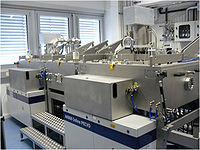Difference between revisions of "Gas Coaters"
Jump to navigation
Jump to search
PurplePen19 (talk | contribs) |
|||
| (2 intermediate revisions by one other user not shown) | |||
| Line 1: | Line 1: | ||
[[Category:Particle Formation]]{{Knoppen}} | [[Category:Particle Formation]]{{Knoppen}} | ||
[[File:Gas Coaters_1.jpg|thumb|200px|right|Gas Coaters]] | |||
[[File: | |||
''' | '''Gas Coaters''' are used in methods to produce thin films using solutions, suspensions or liquid precursors (chemical preliminary stage). Preferentially, it is applied for expensive or minor amounts of source solution. A solution is applied on a rotating substrate and nearly completely removed by spinning, so that only a thin film remains (see schematic view below). | ||
Additionally, the majority of the eliminated solution can be collected and led back. Depending on the desired properties of the film the viscosity, the wetting behavior and, if necessary, the solids content will be modified. | |||
==Video== | ==Common Applications== | ||
<youtube> | *Protective coatings (e.g. scratch resistance, diffusion barrier) | ||
*Transparent, conductive oxides (e.g. ZnO) | |||
*(Semi-) metal thin films (e.g. doped silicon films with different degrees of crystallization) | |||
*Masks for semiconductor industry | |||
*Optically active films (e.g. phosphors ) | |||
==Related Video== | |||
<youtube>dt4Cu7uWCug</youtube> | |||
Latest revision as of 09:13, 28 June 2022
Gas Coaters are used in methods to produce thin films using solutions, suspensions or liquid precursors (chemical preliminary stage). Preferentially, it is applied for expensive or minor amounts of source solution. A solution is applied on a rotating substrate and nearly completely removed by spinning, so that only a thin film remains (see schematic view below).
Additionally, the majority of the eliminated solution can be collected and led back. Depending on the desired properties of the film the viscosity, the wetting behavior and, if necessary, the solids content will be modified.
Common Applications
- Protective coatings (e.g. scratch resistance, diffusion barrier)
- Transparent, conductive oxides (e.g. ZnO)
- (Semi-) metal thin films (e.g. doped silicon films with different degrees of crystallization)
- Masks for semiconductor industry
- Optically active films (e.g. phosphors )
Related Video
